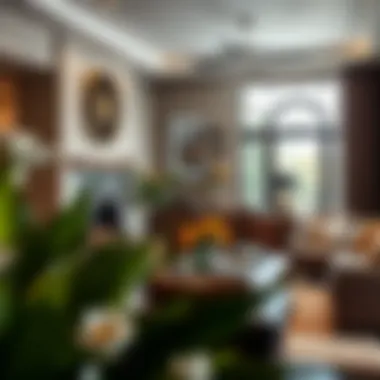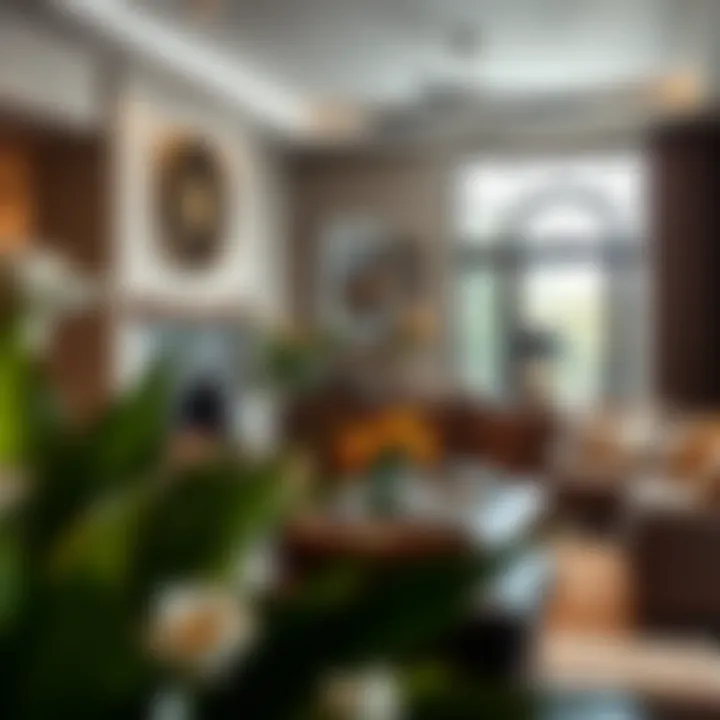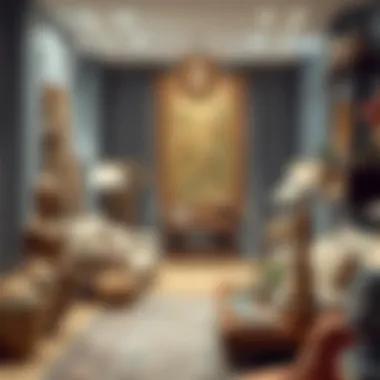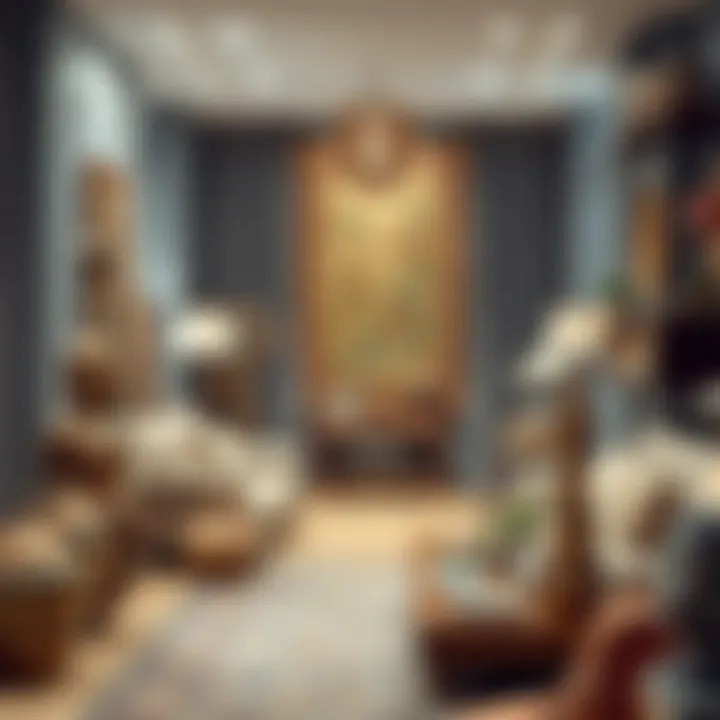Heritage Decor: Infusing Culture into Modern Spaces


Intro
Heritage decor serves as a bridge between the past and the present, intertwining cultural significance with modern aesthetics. In a world where globalization can sometimes dilute unique identities, this style breathes life into contemporary spaces while honoring age-old traditions. It’s not just about choosing decor that looks good; it’s about making choices that resonate with personal history and shared culture. This article will explore how integrating traditional elements into modern interiors not only elevates a space but also tells a story of heritage.
Cultural identity and craftsmanship play pivotal roles in heritage decor, and this guide will take you through various styles, trends, and principles for selecting authentic pieces. Whether you are an investor, realtor, developer, or a prospective buyer in Dubai's lively real estate scene, understanding these elements can provide you with an edge in your endeavors.
As the real estate market in Dubai continues to evolve, awareness of heritage decor can influence property values and appeal, enriching investments. This article will unpack market analysis, investment opportunities, and the overall influence of cultural decor on design choices in modern living spaces.
Defining Heritage Decor
Heritage decor represents more than just a style of furnishing; it's a window into the soul of cultures and histories around the globe. Understanding this concept is essential for architects, interior designers, and anyone involved in real estate who wishes to create spaces that resonate with depth and meaning. By blending elements of history with modern aesthetics, heritage decor can transform ordinary places into extraordinary experiences.
An Overview of Cultural Significance
Every piece within a heritage decor theme tells a story. It reflects the traditions, beliefs, and artistic endeavors of its origin. This is notable in various cultural artifacts—from Mexican talavera tiles to Indian block prints—each item not merely existing in its form but pulsating with life, history, and heritage.
Thus, when integrating cultural elements into decor, one isn’t just choosing an accessory; they are embracing a legacy. Connecting spaces with cultural significance helps foster community and connection. Furthermore, in a city like Dubai, where diverse cultures coexist, heritage decor can serve as a touchstone for identity and belonging.
"Cultural expressions through decor allow people to feel at home, even when miles away from where they come from."
This richness in cultural significance adds depth to spaces, appealing to buyers and investors looking for unique offerings. A home or business adorned with authentic cultural elements can stand out in a crowded market, increasing its intrinsic value.
Distinction Between Heritage and Modern Decor
While both heritage and modern decor serve the purpose of beautifying space, they do so from different angles. Heritage decor focuses on using traditional materials, techniques, and motifs that have been passed down through generations. This kind of decor is often characterized by intricate designs, textures, and colors that reflect a cultural narrative.
In contrast, modern decor leans toward minimalism, sleek lines, and often a neutral palette. It’s a departure from historical references, capturing the essence of contemporary living with an emphasis on functionality and simplicity.
This doesn't mean modern decor can't be influenced by heritage; the fusion of these two styles can yield stunning results. For example, a modern apartment might incorporate antique furniture pieces, tapestries, or pottery that tell a story of the owner’s heritage while maintaining a minimalist aesthetic.
- Heritage Decor Features:
- Modern Decor Features:
- Rich textures and intricate patterns
- Use of traditional, often artisanal materials
- Historical references in design and function.
- Clean lines with minimal ornamentation
- Focus on functionality over form
- Use of industrial materials like metal, glass, and concrete.
Understanding these distinctions is key when developing spaces for different clientele. Buyers might seek the charm of heritage aesthetics for personal resonance, while others may prefer the clean slate that modern decor provides. Therefore, acknowledging and articulating these differences can spice up marketing strategies and enhance consumer appeal.
Historical Context of Heritage Decor
Understanding the historical context of heritage decor not only sheds light on its aesthetic charm but also uncovers the rich tapestry of cultural narratives it embodies. This section explores how decor styles have been shaped by historical movements, regional characteristics, and cultural exchanges. The significance of recognizing these influences lies in appreciating how they inform modern designs and contribute to an enriched understanding of identity in contemporary spaces.
Regional Influences on Decor Styles
Heritage decor isn’t created in a vacuum. It emerges from specific cultural backdrops that exhibit unique styles and principles. For instance, consider the Indian influence of vibrant textiles and intricate patterns that finds its roots in centuries of craftsmanship and trade. Similarly, Moroccan decor is steeped in bold colors and geometric patterns, reflecting the region's diverse history and blending of cultures. These regional influences serve as visual representations of societal values and day-to-day life.
- Artisan Techniques: Understanding that techniques may evolve but remain grounded in their origins is crucial. For instance, the use of hand-woven carpets in Persian decor still speaks volumes about the nomadic history of the region.
- Symbolic Elements: Decor items often carry strong symbolic meanings. In Chinese heritage, for example, dragon motifs symbolize power and strength, making their appearance in designs a bold statement of cultural pride.
This connection emphasizes how regional characteristics contribute to defining not just the decor itself but the emotional resonance it carries.
Evolution Through Different Eras
The landscape of heritage decor has significantly transformed through various historical epochs. When we look back, the convergence of different eras—from the opulence of the Baroque style seen in 17th century Europe to the minimalist yet culturally rich approach of the 20th century—demonstrates this evolution.
- Historical Shifts: The impact of events such as the Industrial Revolution introduced mass production, which contrasted sharply with the artisanal quality of earlier decorative practices. This shift prompted a longing for decorative styles that offered both authenticity and individuality, leading to movements like Arts and Crafts.
- Cultural Syntheses: As cultures collided through colonization and globalization, new styles emerged. For example, the Art Deco movement of the 1920s blended European styles with influences from African and Asian motifs, demonstrating a fusion of aesthetics and practical design.
The historical context reveals the cyclical nature of decor styles, where old traditions surface anew and adapt to contemporary sensibilities.
This evolution is vital for any investor, realtor, or developer looking to integrate heritage decor into modern spaces, as it highlights not just the aesthetic quality but also the storytelling capabilities ingrained within each piece. Without acknowledging this history, one risks overlooking the depth that makes heritage decor a powerful component in today’s design landscape.
Core Elements of Heritage Decor
Heritage decor is more than just a matter of aesthetic appeal; it is about infusing spaces with rich cultural narratives and traditions. At the heart of this design ethos lie several essential elements that contribute to its authenticity and charm. Understanding these core components is vital for anyone looking to create or appreciate an environment that resonates with history and identity.


Textiles and Fabrics
Textiles play a crucial role in heritage decor, serving as both functional and ornamental elements. Traditional fabrics often bear symbolic meanings and unique characteristics that tell stories of their origins. For instance, Persian rugs are not merely floor coverings. They're intricate art pieces reflecting centuries of craftsmanship, with patterns that often represent nature, spirituality, or specific regions. Similarly, Indian block-printed fabrics offer vibrant patterns, carrying the heritage of artisanal techniques passed down through generations.
Benefits of using traditional textiles include:
- Enhanced Comfort: The softness of fabrics like silk or wool makes interiors feel inviting.
- Cultural Connection: Fabrics can evoke emotions and memories, linking individuals to their roots or inspiring travel.
- Sustainability: Many heritage textiles are made using eco-friendly practices, preserving the environment while honoring tradition.
When choosing textiles, consider not just the colors and patterns but also their story—each thread often carries a piece of history.
Artistic Craftsmanship
Craftsmanship echoes through the ages, showcasing the skill and dedication of artisans who have honed their trades over time. This artistic approach to decor breathes life into spaces, offering an unmatched authenticity found only in handmade goods. Pottery from Portugal, wooden furniture from Italy, or intricate carvings from India reflect the meticulous attention to detail and cultural significance behind each piece.
The value of craftsmanship in heritage decor extends beyond aesthetics:
- Investment in Quality: Handmade items generally last longer, terming them a wise investment.
- Support Local Economies: Purchasing artisanal goods helps sustain local communities and preserves traditional skills.
- Unique Identity: Every handcrafted piece is unique, adding a personal touch that mass-produced items can't replicate.
Artistic craftsmanship adds character, transforming ordinary spaces into extraordinary environments rich with meaning.
Color Palettes and Patterns
Colors and patterns are the language through which heritage decor communicates its essence. They evoke emotions and set the mood of a space. Traditional designs often utilize colors that reflect the surrounding landscape or cultural significance, be it the earthy tones found in Native American designs or the bold hues of Moroccan tiles. Patterns such as the intricate geometric shapes found in Islamic art speak to centuries of mathematical inspiration and aesthetic beauty.
When integrating color palettes and patterns:
- Consider Harmony: Ensure that the colors complement the overall theme of the space. Earthy tones paired with vibrant accents can create balance.
- Respect Traditions: Certain colors or patterns hold specific meanings; understanding these can deepen the impact of a decor choice.
- Mixing Modern with Heritage: It’s possible to blend modern aesthetics with traditional patterns. Think of contemporary furniture accented with ethnic textiles, bridging gaps between past and present.
In heritage decor, color and pattern aren’t just decorative but serve as cultural narratives, telling stories of the lives and traditions they represent.
In summary, the core elements of heritage decor—textiles, craftsmanship, and color palettes—are not mere decorative choices but powerful components that enrich spaces, evoke emotions, and honor the stories of cultures past.
Importance of Authenticity
In the realm of heritage decor, authenticity stands as a keystone element, weaving together cultural narratives and enhancing the overall aesthetic of a space. True heritage decor echoes the history, values, and artistry of its origin, creating not just visual appeal, but also fostering deeper connections among people and their environments. By embracing authentic elements, one can cultivate an atmosphere that honors tradition while seamlessly integrating it into modern contexts.
Preserving Cultural Heritage
Heritage decor plays a pivotal role in preserving cultural heritage, acting as a bridge linking generations. When authentic items from a particular culture are deliberately integrated into design, they spark conversations that go beyond aesthetics, encouraging a dialogue about history and cultural values. For instance, indigenous textiles or handcrafted ceramics not only enhance visual interest but also carry stories steeped in identity and tradition.
This preservation becomes increasingly important in a rapidly globalizing world. A unique décor piece can be a powerful reminder of a culture’s uniqueness and the communities that fostered it. Additionally, governments and cultural institutions often support initiatives aiming to protect and promote traditional crafts, recognizing their value in cultural identity. According to the UNESCO Convention for the Safeguarding of the Intangible Cultural Heritage, maintaining these traditions enriches the cultural tapestry of society.
- Benefits of Preserving Cultural Heritage:
- Fosters community pride
- Encourages intergenerational discourse
- Promotes tourism and economic growth
Utilizing original artifacts can draw attention to a culture’s rich narrative, encouraging others to appreciate and maybe even replicate these practices. Thus, authenticity in heritage decor is not simply about decoration; it represents a commitment to preserving the past for future generations.
Cherishing Artisanal Techniques
In a world teeming with mass production and cookie-cutter design, cherishing artisanal techniques becomes not just desirable but essential. These techniques are often passed down through generations, representing a wealth of knowledge and skills that are at risk of being lost in the modern rush for efficiency.
By integrating artisanal pieces into decor, one highlights the craftsmanship and labor put into each item. For example, handmade pottery or textiles reflect meticulous techniques that carry each maker's unique touch. Such pieces not only enhance the visual fabric of a space but serve as tangible connections to the cultural practices that birthed them.
Artisans create with intention. They often blend local materials with traditional methods, ensuring that every piece not only fulfills a decorative purpose but also asserts a cultural statement. This commitment to craftsmanship leads to more sustainable and meaningful consumption.
- Emphasizing Artisanal Techniques:
- Encourages local economies
- Offers unique, one-of-a-kind pieces
- Reduces waste compared to mass-produced items
In summary, authenticity in heritage decor goes hand-in-hand with the preservation of cultural heritage and the celebration of artisanal techniques. It's a powerful reminder that, while styles may evolve, the stories and techniques that shape our environments remain timeless at their core.
Integrating Heritage Decor into Modern Spaces


Integrating heritage decor into modern spaces serves as a bridge where past and present harmonize, creating an environment rich in cultural significance while still appealing to contemporary tastes. As societies become ever more globalized, the need for distinctive design elements that tell a story is paramount. So, how do we fuse these two seemingly disparate worlds? The key lies in understanding specific elements, recognizing the benefits, and considering the challenges of such integrations.
Balancing Tradition and Contemporary Design
To marry tradition with modern aesthetics is akin to a dance where both partners must find a rhythm. Balancing heritage decor with contemporary design doesn't mean overhauling one in favor of the other. Instead, it focuses on integrating traditional pieces thoughtfully within modern settings. Here’s how you might achieve that:
- Select Key Pieces: Not every traditional artifact needs to be showcased. Choose a few standout items, like a vintage rug or an intricately carved wooden table, to serve as focal points.
- Color Schemes: Use a contemporary palette that complements the tones of heritage items. For instance, pairing earthy tones with vibrant, aged textiles can create a stimulating yet harmonious atmosphere.
- Incorporate Modern Materials: Pair natural elements, such as hardwood or stone, with modern materials like glass or metal. This juxtaposition can emphasize the beauty of both styles.
"Heritage decor doesn’t need to be loud to make a statement; sometimes, subtlety speaks volumes."
By implementing these strategies, spaces can evoke a sense of nostalgia while still feeling fresh and current. However, the challenge remains: ensuring that these elements don't clash but instead elevate the overall decor experience.
Creating Cohesive Spaces with Heritage Accents
Heritage accents can transform a typical room into a narrative of culture and history. When applied thoughtfully, they establish a cohesive aesthetic that resonates with occupants and visitors alike. Here are some considerations to keep in mind:
- Strategic Placement: Positions of heritage pieces are crucial. A traditional artifact placed in an unexpected area can draw attention and provoke conversation. Consider mixing items by style and era; an antique lamp can comfortably sit alongside a modern sofa if placed correctly.
- Layering Textures: Use varied textures to create depth. For example, mixing a smooth, contemporary chair with a rough-hewn heritage side table can produce a tactile richness that enhances the space's appeal.
- Consistent Themes: Whether it's through color, pattern, or form, ensure your heritage accents reflect a consistent theme that ties back to the overall design. This helps the room feel intentional rather than chaotic.
Through strategic integration, it is possible to create environments that are not only visually stimulating but also carry emotional weight. Spaces can be affirmations of identity, nostalgia, and forward-thinking design philosophy, offering everyone from investors in Dubai's real estate market to homeowners an inviting atmosphere that resonates across cultures and tastes.
Contemporary Trends in Heritage Decor
Heritage decor is more than just a style; it's a reflection of culture, history, and identity. As we navigate the modern age, the integration of heritage elements is increasingly capturing the hearts of interior designers and homeowners alike. This section unpacks the contemporary trends in heritage decor, highlighting how these elements not only beautify spaces but also resonate with deeper meanings rooted in tradition.
Sustainability and Eco-Friendly Practices
Amidst the present climate consciousness, sustainability is becoming a linchpin in the world of design. The increasing awareness of environmental issues has pushed both consumers and designers to rethink their choices. Here are several ways in which sustainability harmonizes with heritage decor:
- Use of Recycled Materials: Many artisans are now sourcing old materials from demolished buildings or sustainable timber. This practice not only cuts down waste but also adds character to new pieces, as every mark and scratch tells a story.
- Locally Sourced Ingredients: Creating decor with local materials reduces transportation emissions and supports community artisans. Think about fabrics made from indigenous plants or clay sourced from nearby rivers. It’s a beautiful way to honor culture while being eco-conscious.
- Timeless Design: Instead of following fleeting trends, heritage decor often emphasizes longevity. Investing in well-made pieces can lead to a better return on investment, both financially and environmentally.
These practices bring a fresh yet respectful approach, weaving modern ethics into age-old traditions. Such sustainability efforts not only enhance the aesthetic of spaces but also promote a responsible narrative around heritage.
Digital Applications of Heritage Design
With the advent of technology, the world of heritage decor has stepped into the digital realm, paving new avenues for creativity and accessibility. The rise of digital applications offers exciting possibilities, blurring the lines between traditional craftsmanship and technological innovation:
- Virtual Reality Tours: Immersive technologies allow potential buyers and renters to experience heritage homes in a virtual space. This can showcase features like intricate woodwork and traditional textiles that convey the essence of heritage within the hustle of modern real estate.
- Online Customization Tools: Websites now offer platforms where users can customize elements of heritage decor in real-time. Whether it’s choosing colors or materials, this quality of engagement fosters a sense of ownership and pride in one's cultural heritage.
- Social Media Inspirations: Platforms like Instagram and Pinterest help spread ideas rapidly, creating a global community that shares and celebrates heritage decor. What one might think is a local style could inspire designs across continents, intertwining cultures.
The application of digital tools not only magnifies accessibility but also serves as a bridge connecting diverse design philosophies. As more people embrace this blend of tradition and innovation, it reshapes interpretations of heritage living today.
"Heritage decor, when intertwined with modern practices, becomes a canvas illustrating our past, present, and future."
In wrapping up this exploration of contemporary trends, it's clear that these movements are vital to maintaining the relevance of heritage decor within modern circles. The marriage of sustainability with digital applications creates a dialogue that propels the significance of heritage into the future.
Case Studies of Successful Implementations
Delving into case studies of successful implementations of heritage decor not only showcases its potential but also provides valuable insights into practical applications. These real-world examples illustrate how the thoughtful integration of cultural elements can result in visually striking and meaningful spaces. For investors, realtors, developers, buyers, and renters, such case studies offer a roadmap to appreciate the nuances of design that honor tradition while meeting modern expectations. It emphasizes that heritage decor is not merely an aesthetic choice, but a dialogue with history that resonates with diverse audiences.
Residential Spaces: Blending Tradition with Comfort
Residential spaces that embrace heritage decor successfully marry traditional craftsmanship with contemporary comfort. Take, for example, a home in the heart of Dubai that highlights Moroccan tile work alongside modern minimalist furniture. The intricate patterns of the tiles serve as a stunning backdrop, adding vibrancy and warmth to an otherwise sleek and uncomplicated setting.
Benefits of This Approach:
- Emotional Connection: Homeowners often express a sentimental connection to their cultural roots, which can be expressed through decor. Incorporating elements like mosaic tiles or traditional textiles engenders a sense of belonging.
- Unique Character: Homeowners can personalize homes with distinctive design choices, making them reflect individual tastes while honoring cultural nuances.
- Enhanced Market Value: Properties that utilize heritage decor can attract buyers seeking unique charm, which can translate to higher property values.
However, it’s vital to balance tradition with modern living needs. For instance, a family might incorporate traditional handwoven textiles in upholstery but opt for contemporary furniture forms that prioritize comfort and functionality. The challenge lies in executing this blend without overwhelming the space, ensuring it remains inviting and liveable without losing character.
Commercial Spaces: Capturing Identity and Engagement
Similarly, commercial spaces are increasingly tapping into heritage decor to create environments that capture the essence of their brand identity while fostering customer engagement. Consider a boutique hotel that incorporates local artisanal craft, such as hand-carved wood furnishings and regional paintings.
Key Considerations for Commercial Spaces:


- Brand Storytelling: Utilizing elements rooted in local culture helps businesses tell their stories. For example, a restaurant showcasing Nubian artifacts not only enhances the ambiance but also conveys cultural richness to patrons.
- Space Utilization: Commercial areas need to consider foot traffic and flow. Heritage elements, like large tapestries or woven baskets, can act as natural dividers, creating cozy nooks without the need for temporary partitions.
- Customer Experience: By creating immersive environments, businesses can engage customers on a deeper level. When patrons feel a connection to the decor, it can positively influence their experience and encourage repeat visits.
Integrating heritage decor in commercial settings can transform spaces from mere transactional environments into emotional, vibrant experiences.
In essence, the careful implementation of heritage decor can elevate both residential and commercial settings, enriching customer and occupant experiences alike. As these case studies reveal, successful design is about more than aesthetics; it’s about fostering connections to heritage and identity, enhancing comfort, and ultimately, driving value in today’s competitive market.
Challenges in Maintaining Heritage Decor
Maintaining heritage decor is no small feat, and its importance can't be overstated in our exploration of this majestic topic. Heritage decor is a bridge that connects the past with the present, enriching our living spaces with cultural anecdotes and artistry. However, this very essence often presents unique challenges that stakeholders must navigate.
Navigating Market Trends and Consumer Preferences
In today’s fast-paced world, market trends shift like sand underfoot. This creates a complex backdrop against which heritage décor must coexist. Consumers are increasingly drawn to modern aesthetics, which can sometimes overlook the rich narratives behind traditional design elements. The modern-day buyer wants functionality but often favors sleek lines and minimalism over intricate patterns reminiscent of bygone eras.
To capture the attention of discerning clients, it’s essential to marry these opposing tastes. Preservationists and retailers can offer hybrid designs that echo heritage while accommodating contemporary demands. For instance, using sustainable materials can attract eco-conscious consumers, while artistically fusing age-old craftsmanship with modern ergonomic designs can keep the heritage spirit alive without jeopardizing market appeal. Understanding local trends and preferences is crucial; for example, in Dubai, where cultural diversity flourishes, implementing designs that reflect this mosaic can resonate more with buyers.
Balancing Cost with Authenticity
The age-old saying, "You get what you pay for," rings especially true in the realm of heritage decor. Authenticity often comes at a price, and this can put buyers in a tight spot. On one hand, preserving traditional techniques and materials is vital to maintaining the cultural integrity of design elements. On the other hand, the costs associated with sourcing genuine artisans and high-quality materials can escalate quickly, especially in today’s competitive marketplace.
Here’s where the fine balance lies. Stakeholders must weigh their budget against the value of authenticity. It might be tempting to opt for cheaper alternatives that mimic authentic features. However, this often results in a diluted aesthetic that fails to capture the original essence and significance of heritage decor.
Investing in authentic pieces might mean fewer items, but each will undeniably carry greater weight and story. Educating buyers about the value of authenticity—be it through storytelling, demonstrations, or immersive experiences—can enhance appreciation and justify the investment.
"In the end, authenticity isn’t just about the item; it’s about the story it tells and where it comes from."
Ultimately, navigating these challenges demands a deep understanding of both the heritage we seek to preserve and the modern world we live in. The successful fusion of these realms can lead to spaces that don't just look good but resonate on a deeper level with those who inhabit them.
Future Directions of Heritage Decor
In the evolving landscape of home and commercial design, understanding the future directions of heritage decor becomes vital. This section looks into innovative solutions and considers how traditional themes can synergize with modern ideas. As consumers and designers become more conscious of authenticity and sustainability, the focus shifts to designs that respect heritage while adapting to contemporary needs.
Innovative Designs Inspired by Tradition
One of the exciting aspects of heritage decor is how it meets innovation head-on. Designers today are not just revisiting traditional elements; they're reinterpreting them in ways that resonate with modern sensibilities. For instance, a traditional Persian rug might meet contemporary geometric patterns, creating an intriguing dialogue between the old and the new.
Some elements to explore in this context include:
- Fusion of Techniques: Combining ancient weaving techniques with modern dyes leads to vibrant new textile designs that carry cultural weight yet suit minimalistic spaces.
- Adaptive Reuse: Vintage furniture can be revamped to meet modern functional needs while retaining its historical essence, merging nostalgia and practicality.
Moreover, incorporating cutting-edge technology, like 3D printing, allows artisans to recreate complex historical motifs with accuracy. This method not only saves time but also preserves dynamic craftsmanship that would otherwise be lost. Such innovative designs cater to discerning buyers looking for authenticity amid convenience, enriching experiences and enhancing spaces culturally.
"Heritage decor isn't merely a trend; it is an evolving narrative that tells the story of our past as it shapes our future."
Globalization and Its Impact on Local Styles
Globalization has made the world interconnected; it also casts shadows over local decor styles. While cultural exchanges lead to exciting mingling of traditions, there’s a double-edged sword here. Local designs face dilution as global trends encroach upon distinct styles, which can result in a homogenization of decor.
On the flip side, globalization can bolster heritage decor by fostering a renewed interest in local crafts. Here are points to consider:
- Broader Market Access: Artisans gain an audience beyond their immediate region, making local crafts viable in new markets, thus sustaining traditional practices.
- Cultural Collaboration: Cross-continental partnerships can create novel hybrids of styles. For example, a Japanese Shoji screen adapted with Scandinavian design elements merges functionality with artistic expression.
- Awareness and Engagement: Increased travel and exposure mean more people are interested in authentic cultural experiences, leading to a greater appreciation of heritage in design.
As we embrace globalization, the challenge remains to celebrate individuality and authenticity rather than yield to trends that overshadow heritage. Conscious choices in decor can foster a foundation where local traditions thrive alongside innovative solutions.
Epilogue: The Value of Heritage in Modern Design
Heritage decor plays a pivotal role in shaping not only personal spaces but also the very essence of modern design. By weaving threads of cultural identity and tradition into contemporary interiors, it fosters a unique dialogue between past and present. This approach cultivates spaces that are not just aesthetically pleasing but deeply resonant with history, essence, and the stories that define them.
Embracing the Past for Future Inspiration
Heritage decor invites us to look back in order to move forward. Whether it is a bold color palette influenced by indigenous textiles or the craftsmanship found in artisanal furniture, each element brings a sense of authenticity to a space. Investors, realtors, developers, and potential buyers or renters alike can find value in embracing these historical touches.
By integrating heritage elements into modern design, one can stimulate a narrative that adds depth to an otherwise sterile environment. For instance, consider incorporating traditional Moroccan tiles in a contemporary kitchen or using Japanese tatami mats in an urban apartment. Such choices not only elevate the style of the space but also tell stories that transcend generations.
"The future belongs to those who believe in the beauty of their dreams." - Eleanor Roosevelt
This philosophy applies marvelously to the realm of design, where dreams of culture and history intersect with modernity.
Additionally, the challenge lies in striking the right balance between honoring tradition and catering to evolving tastes and technologies. To do this effectively requires an understanding of the cultural context and the ability to adapt it in a way that remains relevant. Therein lies the beauty of heritage decor: it not just preserves the past but also embellishes the present, paving the way for a sustainable future.
To sum it up, the integration of heritage decor in modern design isn't just a trend; it's a profound statement of identity and community. As society becomes increasingly interconnected due to global influences, creating spaces that reflect genuine cultural narratives will become even more critical. Every design decision made today is a brushstroke on the canvas of tomorrow, ensuring that our history not only survives but thrives in the modern age.











